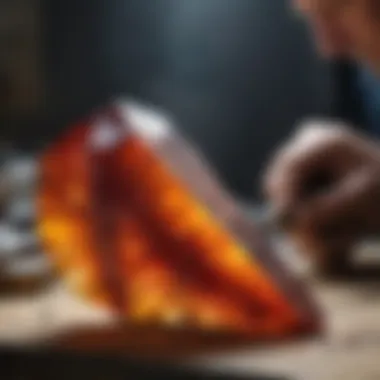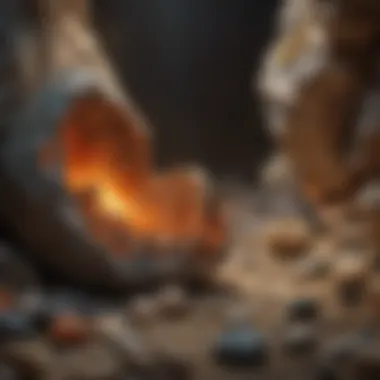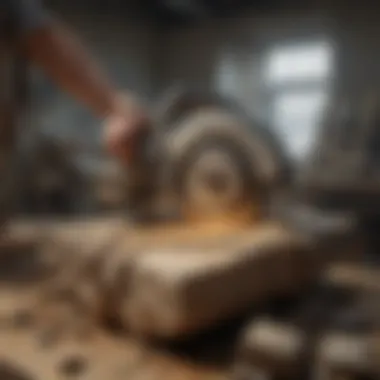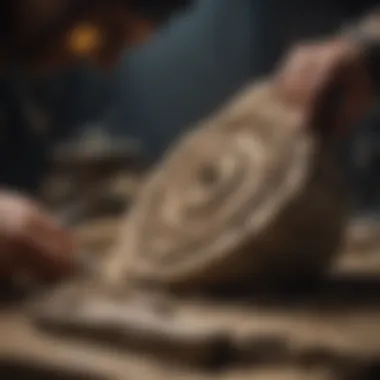Unraveling the World of Rock Saws: A Comprehensive Guide for Enthusiastic Collectors


Rock and Fossil Identification
Rock and Fossil Identification presents a crucial foundation for rock and fossil collectors to distinguish between different geological specimens. Understanding the various types of rocks and fossils is paramount in this pursuit and involves recognizing key characteristics that denote specific mineral compositions or prehistoric organisms trapped within. Tools for identification, ranging from magnifying lenses to UV lights, aid in scrutinizing textures, colors, and formations, enabling enthusiasts to classify specimens accurately with precision and expertise.
Collecting Tips and Techniques
Delving into Collecting Tips and Techniques unveils a realm of practices essential for both novice and seasoned collectors in their pursuit of geological treasures. Best practices for collecting emphasize systematic approaches, detailing methods to carefully unearth specimens without damaging their integrity. Locating prime collecting sites entails thorough research into geological maps, understanding the significance of specific rock formations, and exploring regions with promising fossil deposits. Safely extracting specimens involves utilizing specialized tools like chisels and brushes to gently remove rocks or fossils embedded in layers of sediment, ensuring minimal disturbance to the surrounding environment.
Preservation and Display
Preservation and Display illuminate the post-collection phase, focusing on maintaining the pristine state of acquired rocks and fossils for long-term enjoyment and educational purposes. Techniques for preserving rocks and fossils include cleaning methods to remove dirt and debris without altering the specimen's natural properties. Proper storage encompasses considerations of humidity levels, temperature control, and protection from light exposure to prevent degradation over time. Creative display ideas cater to showcasing collections attractively, from minimalist shelving units to intricately designed museum-like exhibits that highlight the artistic and scientific value of each specimen.
Geological Insights
Exploring Geological Insights transports readers into the dynamic world of geological formations, shedding light on the intricate processes that have shaped the Earth's surface over millennia. Diving into the historical significance of rocks and fossils unveils a narrative of ancient ecosystems, climatic changes, and evolutionary milestones captured within these geological artifacts. Notable discoveries in the field underscore the contributions of paleontologists and geologists in unraveling Earth's history and expanding our knowledge of past life forms and geological events through meticulous excavation and analysis.
Introduction to Rock Saws
In this article, we embark on a journey to unravel the complexities of rock saws, essential tools for rock and fossil collectors. As we delve deep into the world of rock cutting, the significance of rock saws becomes apparent. Rock saws play a vital role in extracting and preparing geological specimens, a process crucial for geological exploration. Understanding the nuances of rock saws can greatly enhance the efficiency and precision of specimen preparation, making it a key topic of discussion throughout this guide. From basic cutting techniques to advanced applications, the knowledge gained from this exploration will undoubtedly benefit rock and fossil collectors in their pursuits.
Understanding the Role of Rock Saws
The Evolution of Rock Cutting Techniques
Diving into the evolution of rock cutting techniques unveils a fascinating journey of innovation and technological advancement. The evolution has revolutionized specimen preparation, paving the way for more precise and efficient cutting methods. One key characteristic of this evolution is the gradual shift towards finer and more accurate cutting mechanisms, enabling collectors to extract specimens with greater precision. Despite some challenges posed by the complexity of modern cutting techniques, the evolution has significantly improved the quality of prepared specimens, making it a popular choice among collectors and researchers alike. The unique feature of these advanced techniques lies in their ability to achieve ultra-thin cuts with minimal waste, enhancing the overall efficiency of specimen processing.
The Significance of Precision Cutting in Specimen Preparation
Precision cutting holds immense value in the realm of rock and fossil collection, playing a crucial role in preparing delicate specimens for study. The meticulous nature of precision cutting ensures that specimens are accurately sliced to reveal intricate details without causing damage. This level of precision is essential for conducting detailed analyses and examinations of geological samples, making it a favored approach among collectors seeking accuracy and finesse in specimen preparation. While precision cutting may require specialized equipment and expertise, its advantages in ensuring high-quality results far outweigh any potential drawbacks. The unique feature of precision cutting lies in its ability to achieve microscopically thin sections, allowing collectors to uncover hidden details within their specimens with utmost clarity.
Types of Rock Saws
Diamond Blade Saws


Diamond blade saws represent a pinnacle in rock cutting technology, known for their exceptional precision and cutting power. The key characteristic of these saws is their ability to slice through even the hardest rock materials with ease, making them a popular choice for cutting gemstones and tough specimens. The unique feature of diamond blade saws is their durability and longevity, providing collectors with a reliable tool for long-term use. While diamond blade saws offer unmatched cutting capabilities, their main disadvantage lies in the cost of maintenance and blade replacement, which can be a consideration for collectors seeking cost-effective solutions.
Wire Saws
Wire saws introduce a versatile cutting method that allows collectors to achieve intricate shapes and cuts with high precision. The key characteristic of wire saws is their flexibility, enabling users to navigate around complex geological formations with ease. This flexibility makes wire saws an ideal choice for cutting irregular or fragile specimens that require extra care during processing. The unique feature of wire saws lies in their ability to produce smooth cuts without causing unnecessary damage to surrounding materials, making them a preferred tool for delicate cutting operations. Despite their advantages, wire saws may have limitations in cutting through extremely hard rocks, requiring collectors to assess the suitability of these saws based on their specific cutting needs.
Band Saws
Band saws offer a robust cutting solution for collectors handling larger specimens or thick rock slabs. The key characteristic of band saws is their ability to make straight, curved, or irregular cuts with precision and consistency. This versatility makes band saws a popular choice for creating custom shapes and sizes in specimen preparation. The unique feature of band saws lies in their efficiency in processing large volumes of rock material quickly, streamlining the cutting process for collectors handling bulk samples. While band saws excel in their cutting capacity, users may need to ensure proper blade alignment and maintenance to optimize performance and prevent blade wear.
Slab Saws
Slab saws cater to collectors seeking to process thick rock materials into uniform slabs or sections for further examination. The key characteristic of slab saws is their ability to cut through dense rock specimens with ease, producing smooth and even surfaces for analysis. This cutting precision allows users to create standardized samples for various geological studies, enhancing the overall quality of specimen preparation. The unique feature of slab saws is their adjustable blade settings, which permit collectors to customize cut thickness according to their specific requirements. Despite their efficiency in slab cutting, users must exercise caution when handling large specimens to prevent potential blade jams or accidents due to the power required for cutting thick rock layers.
Choosing the Right Rock Saw
Factors to Consider in Selecting a Rock Saw
Selecting the right rock saw requires a careful assessment of various factors, including cutting needs, specimen type, and user experience. The key characteristic to consider is the cutting capacity of the saw, ensuring that it meets the requirements for processing different rock materials effectively. Collectors should also evaluate the durability and reliability of the saw, particularly when handling tough or abrasive specimens that may wear down the equipment over time. The unique feature of factors to consider in selecting a rock saw is the importance of assessing safety features, maintenance requirements, and blade compatibility to ensure smooth and efficient cutting operations. While multiple factors influence the choice of a rock saw, users can prioritize those that align with their specific cutting goals and long-term usability.
Features to Look for in a Quality Rock Saw
When seeking a quality rock saw, certain features can signify a reliable and efficient cutting tool for collectors. The key characteristic to look for is adjustable blade speed and cutting depth, providing users with control over the cutting process for different specimen types. Additionally, built-in safety mechanisms such as blade guards and emergency stops enhance user protection during operation, reducing the risk of accidents or injuries. The unique feature of a quality rock saw lies in its ergonomic design and user-friendly interfaces, offering collectors an intuitive cutting experience that prioritizes safety and convenience. While the range of features in a quality rock saw may vary, users can evaluate these attributes based on their specific cutting requirements and operational preferences to find an optimal tool for their collection endeavors.
Section 2: Rock Saw Techniques and Best Practices
Within the realm of rock cutting tools, the focus shifts towards Rock Saw Techniques and Best Practices, a pivotal segment in the comprehensive guide for rock and fossil collectors. Understanding the intricacies of this topic is essential for enthusiasts eager to delve deeper into geological specimen preparation. This section serves as a foundation for mastering the art of rock cutting, offering insights into specific elements, benefits, and considerations surrounding Rock Saw Techniques and Best Practices.
Safety Precautions and Gear
Protective Equipment for Rock Cutting
In the quest for safe and efficient rock cutting, the importance of protective equipment cannot be overstated. Protective gear such as goggles, gloves, and ear protection are indispensable tools that safeguard collectors from potential harm during cutting operations. The key characteristic of protective equipment lies in its ability to provide a barrier against debris, dust, and noise, ensuring a secure work environment. The popularity of these safety measures stems from their proven effectiveness in minimizing risks associated with rock cutting activities. One unique feature of protective equipment is its versatility, adapting to various cutting settings while prioritizing user safety.


Safe Operating Procedures for Rock Saws
When it comes to operating rock saws, following established safety procedures is crucial for both personal well-being and equipment longevity. Safe operating procedures encompass aspects like equipment inspection, proper blade installation, and secure worktable setup. The key characteristic of these procedures is their emphasis on reducing the likelihood of accidents and ensuring precise cuts with minimal disruptions. Adhering to safe operating procedures is a popular choice among collectors seeking to maintain a safe and efficient working environment. An essential unique feature of these procedures is their comprehensive approach, covering every aspect of rock saw operation to mitigate risks effectively.
Basic Cutting Techniques
Straight-line Cutting
Straight-line cutting serves as a fundamental technique in the realm of rock cutting, offering a precise and controlled method for shaping specimens. The key characteristic of straight-line cutting is its ability to create clean, uniform cuts essential for specimen preparation. This technique is popular among collectors due to its simplicity and effectiveness in achieving desired specimen shapes. A unique feature of straight-line cutting is its versatility, allowing for both delicate and robust cuts depending on the specimen's composition.
Circular Cutting
In contrast, circular cutting introduces a more intricate approach to rock shaping, providing collectors with the flexibility to create curved or circular specimens. The key characteristic of circular cutting lies in its ability to sculpt unique shapes not easily achievable through straight-line methods. This technique is popular among enthusiasts looking to create visually striking specimens with intricate designs. A unique feature of circular cutting is its precision in achieving complex shapes, adding a layer of artistry to the specimen preparation process.
Advanced Cutting Methods
Silent Cutting Technology
The integration of silent cutting technology revolutionizes the cutting experience by significantly reducing noise levels during operation. This innovation's key characteristic is its ability to maintain a quiet work environment without compromising cutting precision. Silent cutting technology is a popular choice among collectors working in shared spaces or noise-sensitive areas, as it enables uninterrupted operation without causing disturbances. A unique feature of silent cutting technology is its energy-efficient nature, contributing to sustainable cutting practices while ensuring optimal performance.
Precision Cutting for Delicate Specimens
When delicacy is paramount in specimen preparation, precision cutting techniques come to the forefront, allowing collectors to execute meticulous cuts with finesse. The key characteristic of precision cutting for delicate specimens is its exceptional attention to detail, ensuring minimal material loss and precise shaping. This technique is popular among collectors handling fragile or valuable specimens, as it offers enhanced control and accuracy in the cutting process. A unique feature of precision cutting is its ability to handle intricate designs with utmost precision, making it a preferred method for creating high-quality specimens.
Maintenance and Care of Rock Saws
Rock saws play a crucial role in the meticulous process of extracting geological specimens, making it imperative to understand the significance of maintenance and care to ensure their longevity and optimal performance. Proper maintenance not only enhances the lifespan of the saw but also safeguards the quality of cuts and the safety of the operator. In this section, we will delve into essential maintenance practices that include cleaning and lubrication to preserve the efficiency and precision of rock saws.
Cleaning and Lubrication
Proper Cleaning Techniques for Blade Maintenance
Cleaning the blades of a rock saw is a meticulous process that involves removing dirt, debris, and residues that can affect cutting performance. The proper cleaning of blades ensures that the cutting edge remains sharp, reducing the risk of chipping or uneven cuts. Adopting a systematic approach to cleaning, such as using specialized brushes and solvents, can maintain blade integrity and prolong its usability. Proper cleaning techniques for blade maintenance are fundamental in enhancing the overall cutting efficiency and precision of rock saws.


Lubrication Practices for Optimal Saw Performance
Lubrication is a critical aspect of rock saw maintenance that focuses on reducing friction and heat during cutting operations. Applying the right lubricant helps in dissipating heat generated during cutting, preserving the blades, and enhancing overall saw performance. By incorporating proper lubrication practices, operators can optimize the saw's efficiency, prevent overheating, and extend the lifespan of cutting blades. Thus, selecting appropriate lubricants and establishing regular lubrication routines are crucial for maintaining optimal saw performance.
Blade Replacement and Alignment
Indications for Blade Replacement
Understanding when to replace blades is essential to ensure consistent cutting quality and safety. Signs such as diminished cutting performance, blade wear, or deviation from straight cuts indicate the need for blade replacement. Timely replacement not only improves cutting accuracy but also minimizes the risk of accidents and damage to specimens. Recognizing the indications for blade replacement is pivotal in maintaining the effectiveness and safety of rock saw operations.
Ensuring Blade Alignment for Precise Cuts
Proper blade alignment is instrumental in achieving precise and accurate cuts in rock saw operations. Misaligned blades can result in jagged cuts, material wastage, and compromised specimen quality. By aligning the blades correctly, operators can optimize cutting accuracy, reduce material loss, and enhance the overall quality of the prepared specimens. Ensuring blade alignment through regular checks and adjustments is a fundamental practice for achieving consistent and high-quality cuts.
In essence, the maintenance and care of rock saws encompass a meticulous approach to cleaning, lubrication, blade replacement, and alignment to uphold operational efficiency, cutting precision, and operator safety. By adhering to these maintenance practices, rock and fossil collectors can elevate their cutting capabilities and maximize the utility of these indispensable tools.
Advanced Applications of Rock Saws
In this section of our comprehensive guide on rock saws for rock and fossil collectors, we delve into the intricate realm of advanced applications of these cutting-edge tools. The importance of exploring advanced applications lies in pushing the boundaries of conventional rock cutting techniques and delving deeper into geological specimens. By harnessing advanced applications, collectors can elevate their specimen preparation to unprecedented levels of precision and detail. Understanding the nuances of advanced applications is crucial for those looking to take their rock cutting skills to the next level and unlock the full potential of their specimens.
Thin Section Preparation
Techniques for Creating Thin Sections:
The specialized technique of creating thin sections is a pivotal aspect of rock saw usage in geological exploration. The meticulous process of thin section preparation involves slicing rock samples into wafer-thin sections for microscopic analysis. This technique enables collectors to study the intricate mineral composition and structures of rocks in unprecedented detail. One key characteristic of techniques for creating thin sections is their ability to reveal hidden geological secrets that would otherwise remain unnoticed. Despite the meticulous nature of this process, the benefits of creating thin sections are undeniable, offering invaluable insights into the geological history encapsulated within each specimen.
Utilizing Rock Saws for Petrographic Analysis:
Utilizing rock saws for petrographic analysis opens up a world of possibilities for collectors seeking to unravel the mysteries held within geological specimens. This specific aspect involves cutting samples with precision to analyze their mineralogical and textural properties under a microscope. The key characteristic of this application lies in its ability to provide detailed insights into the mineral composition, fabric, and structural features of rocks. While utilizing rock saws for petrographic analysis requires skill and precision, the benefits of this method far outweigh any challenges, allowing collectors to glean invaluable information essential for understanding the geological evolution of their specimens.
Customizing Specimens
Artistic Cutting of Rocks and Fossils:
Artistic cutting of rocks and fossils adds a creative dimension to rock saw usage, enabling collectors to transform specimens into captivating works of art. This specific aspect involves sculpting rocks and fossils into unique shapes and designs, showcasing their natural beauty in a visually appealing manner. The key characteristic of artistic cutting lies in its ability to blend scientific exploration with artistic expression, offering collectors a chance to appreciate the aesthetic qualities of geological specimens. While artistic cutting requires a delicate touch and an eye for detail, the advantages of this approach include creating visually stunning pieces that intrigue and engage viewers, bridging the gap between art and science.
Creating Display Pieces with Precision Cuts:
Creating display pieces with precision cuts is a meticulous process that enhances the presentation of geological specimens for showcasing or educational purposes. This aspect involves using rock saws to cut and shape rocks and fossils with accuracy and finesse, ensuring they are exhibited in the best possible light. The key characteristic of this method lies in its ability to highlight the unique features of each specimen, creating visually striking displays that capture the attention of viewers. While creating display pieces with precision cuts demands attention to detail and expertise, the advantages of showcasing specimens in this manner make it a popular choice among collectors looking to share their passion for geology with others.







